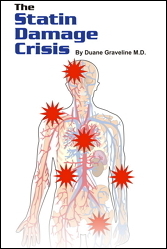The Special Importance of CoQ10
 By Duane Graveline MD, MPH
By Duane Graveline MD, MPH
Statins and Mitochondrial Damage Part 6 of 11
I have reported in the past of the association of statin drug use with such alarming adverse responses as transient global amnesia, behavioral and emotional changes, peripheral neuropathies, myopathies and neuromuscular degenerative condition resembling ALS.
As serious as these conditions are, they pale in significance when compared with the newly recognized effects of statin use on mitochondria. It appears that the most serious side effect of statin drugs by far is their tendency to increase mitochondrial mutations thereby contributing to premature aging and the onset of chronic conditions commonly associated with the aging process. This disastrous adverse response is the predictable consequence of CoQ10 and dolichol inhibition.
Statins are known as reductase inhibitors. When drug companies realized that one of the many steps along the pathway to cholesterol synthesis involved a reductase enzyme, they knew they had found a possible Achilles heel to cholesterol control. From a biochemical viewpoint a reductase step is easy to inhibit and so was born the multi-billion dollar reductase inhibitor class of drugs better know as the statins.
Unfortunately, this reductase step that was so interesting to drug company researchers just happened to be at the very beginning of the mevalonate pathway, responsible for the synthesis not only of cholesterol, our target at that time, but also such vital substances as CoQ10, dolichols and selenoproteins, and even normal phosphorylation.
Anyone who has ever pruned an apple tree knows that if you gird the trunk of the tree, all the branches die, and that is basically what happens with reductase inhibition - you not only inhibit the cholesterol branch you inhibit all the branches using the mevalonate pathway. The process is inescapable.
Obviously many individuals take statins with apparent impunity, implying the presence of alternative pathways yet to be discovered reflecting what doctors have always known: even though we look alike and act alike, we are all different in terms of underlying biochemistry.
Most of us have no awareness of just how critical CoQ10 is to our function, and to think that after the age of 50 we become increasingly unable to synthesize it and must depend almost entirely on what we take in by mouth. Since dietary CoQ10 is almost completely inadequate, unless one is fond of beef heart, supplements become our mainstay of CoQ10 as we age.
Even on our good days mitochondrial mutations occur by the tens of thousands. They are an inevitable consequence of normal metabolic activity. The so-called "reactive oxygen species" such as peroxidases and hydroxyl radicals are produced as a by-product of metabolism and desperately seek electrons to balance their electrical state.
It is this "stealing" of electrons from adjacent tissue, including DNA strands, that causes the damage. We have evolved a very efficient anti-oxidative system for the purpose of minimizing this electron theft. Included in this system are such enzymes as superoxide dismutase and glutathione and such non-enzymatic substances as coenzyme Q10 and vitamins C and E.
Although CoQ10 has plenty of help in its anti-oxidant role, I stress CoQ10's special importance because of its location within the mitochondria as a vital component of both complex one and complex two of the mitochondria's electron transfer sequence. What better location for the job at hand than being physically there where the action is occurring. CoQ10 not only is a vital component in this process of energy formation, it is also superbly placed for its powerful anti-oxidant function.
In concert with the other members of this protective system, CoQ10 suffices to keep oxidative damage to a minimum. What DNA lesions finally occur, after the neutralizing effects of legions of anti-oxidant warriors, are then identified and corrected by another protective system of amazing efficiency.
That tens of thousands of DNA lesions occur daily despite all our anti-oxidant system can do is a sobering reality of the constant skirmish for change, seeking the best solution for meeting environmental change. Fortunately most of these errors never make it beyond the next cell division at which point they are replaced naturally by normal configurations.
The gradual buildup of these DNA errors can result in progressive loss of functional DNA, a frequent cause of chronic disease and the usual cause of aging.
Most of the serious damage is to our bases, those four amino acids: adenine, cytosine, thymine and guanine, comprising our DNA strands. Some of the oxidative damage can be reversed simply by direct chemical means. Far more important to us is the base excision repair process, in which faulty bases must be excised and replaced by correct ones.
This is one of the major repair requirements, occurring tens of thousands of times daily and each one requiring a specific glycohydrolase. Since glycohydrolase is one of our ubiquitous glycoproteins, requiring dolichols for synthesis, one must consider the possibility of altered glycohydrolase availability with statin use. For a far more complete presentation of this well-known process the reader is referred to their favorite search engine for DNA repair mechanisms.
Duane Graveline MD MPH
Former USAF Flight Surgeon
Former NASA Astronaut
Retired Family Doctor






